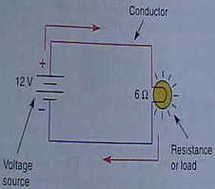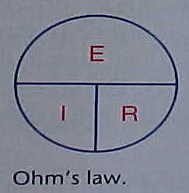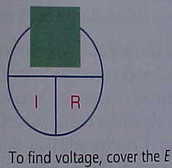This week I wanted to talk about ohms law since I mentioned it in last week’s post about taking the ASE automotive electrical test. Although you may not use this formula while you are solving automotive electrical problems if you plan on passing the electrical test, understanding the law and its principles can really come in handy.

Electrical Circuit
George Ohm is accredited with the term. He was a German mathematics professor and in 1827 wrote a book that included the explanation of how electricity behaved. His thoughts have become the basis for a true understanding of how electricity works.In his book he states that it takes 1 V of electrical pressure to push one amp of electrical current through a 1 ohm resistor. This equation is the basic law of electricity and is known as ohms law. In a practical example a simple electrical circuit can be connected to a voltage source by conductors better known as wiring.
The resistor could be a lamp and the voltage source could be the battery. The two are connected by wiring. In any electrical circuit resistance (R) current (I) and voltage (E) are related to each other in how the circuit will perform. This can be converted into a mathematical equation. This equation can be applied to the entire circuit or just a section of it.
How ohms law works

Ohms Law
The equation is (E) over (I) times (R). When any two factors of the equation are known the third factor can be determined by using ohms law and the mathematical equation. If you are trying to calculate voltage this would equal the current measured in amps multiplied by the resistance measured in ohms.If you are looking for the amperage you would then take the voltage and divide by the resistance that is measured in ohms. To find the resistance you can take the voltage and divide by the current that is measured in amps.
As an automotive mechanic it is important to understand ohms law because it truly explains how an increase or decrease in voltage, resistance, or current can affect the operation and performance of an automotive circuit.
As an automotive mechanic it is important to understand ohms law because it truly explains how an increase or decrease in voltage, resistance, or current can affect the operation and performance of an automotive circuit.
Practical application of ohms law

Finding Voltage
Using the lamp example from above let’s pretend that it is a parking light. If you are trying to calculate how many amps the bulb uses you can measure the resistance of the parking lamp using an automotive meter. You can then take the battery voltage of 12 V and divide it by the resistance to find out exactly how much amp’s the bulb uses.You may be wondering how this can apply to the real world.
What would happen if the resistance in the circuit increased due to a corroded or damaged connection to our parking lamp?
If the corroded connection added to ohms of resistance to the parking lamp circuit the amount of amps flowing through the bulb would be decreased.
What would happen if the resistance in the circuit increased due to a corroded or damaged connection to our parking lamp?
If the corroded connection added to ohms of resistance to the parking lamp circuit the amount of amps flowing through the bulb would be decreased.
If you were looking at this bulb it may not seem to be shining as bright as the other bulbs on the vehicle. With this knowledge you now start checking electrical connections in the parking light circuit that has the dim bulb. And you know what you are looking for an increase in resistance causing a decrease in amperage.
I don’t claim in any way to be an automotive electrical instructor. In fact I am just a mechanic that will be taking the ASE recertification for auto electrical systems for the fifth time. On my other website I have about 10 pages that dive into more automotive electrical theories that you may find helpful for solving car electrical problems. If you are looking for more of the most recent articles on this blog this next link will take you to the homepage from this article about ohms law.
====
What is a Grounded Circuit
A grounded circuit is similar to a short circuit. In that the current bypasses part of the normal circuit path. But in this instance, by going directly to a ground source. An exposed wire directly touching ground may cause this.Also part of the internal circuitry within an electrical component can come in contact with a ground source by touching the housing of the unit itself. You have to remember that in many situations electrical components will be case grounded. This simply means that the attaching bolts provide the system ground for the given electrical circuit.Deposits of oil, dirt and moisture around electrical connections or terminals can provide an excellent path so that the current flows to ground.
This may also cause a grounded circuit condition. Remember that current flows through the path of least resistance in attempting to complete its circle back to ground. These three types of circuit malfunctions are things that you will find as the root cause of your car electrical problems.
You should keep this in the back of your mind when you are using a wiring diagram to diagnose suspected electrically related automobile complaints. Give this circuit malfunctions page a bookmark or share. Then watch some of my exclusive car repair videos from the links below.
Learning more about the basic theory of electricity is valuable knowledge to have under your belt. But more importantly, when you understand how it works diagnosis and auto repair becomes much easier. Learn more from me about automotive electrical.
I put together a repair video that shows you some tricks and techniques I use for quick diagnosis. See the method I was taught for the proper use of automobile wiring diagrams.People seem to like the auto repair how to videos I put together.
Here is one that shows you how to use online car repair manuals.The homepage is available from this next link. You can get a brief summary of what else is covered on this website.
The next link takes you from circuit malfunctions to auto repair advice.